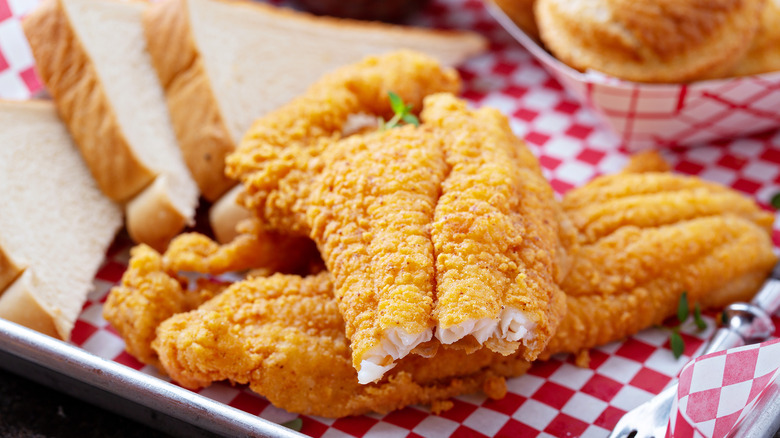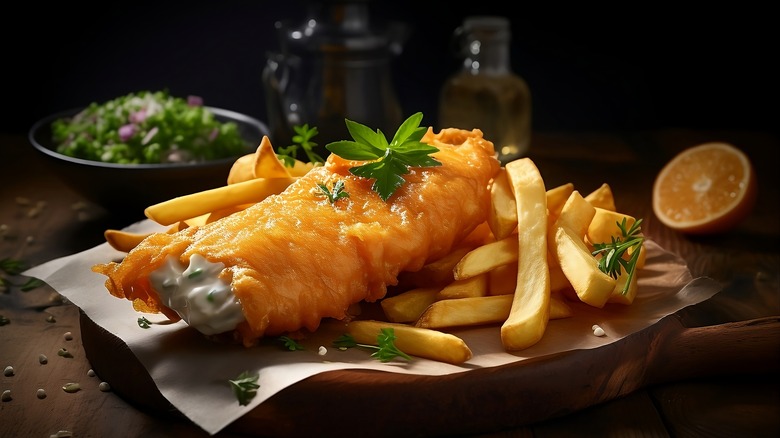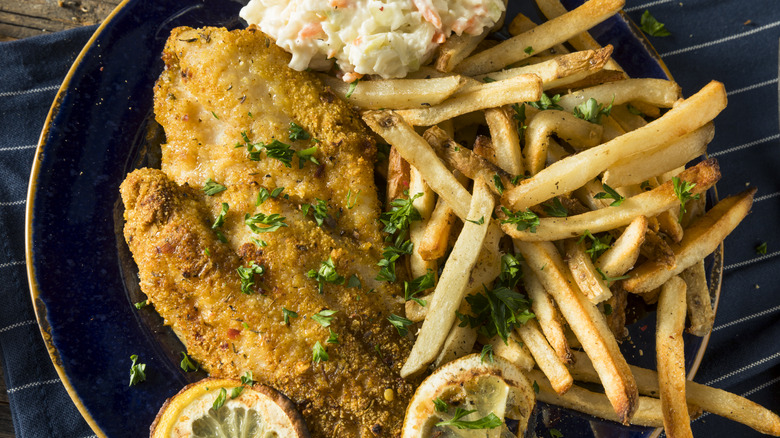The Simple Way To Ensure Your Fried Fish Comes Out As Crispy As Possible
There is nothing more disappointing than frying up a piece of fish, only for it to come out floppy and limp, with a soggy exterior that flakes off in pieces with every bite. This is why the most important thing you can do with fish is to pat it dry before you batter and fry it. Fish is full of water — after all, it comes from the ocean or fresh water and is often packaged in styrofoam and plastic, where it sits in its own juices until you slice it free around dinner time.
The more moisture present on your fish, the less crispy it will get, because moisture causes fish to steam, not fry. And since you're coating it in a wet mixture when you fry it, thoroughly drying it out beforehand is even more crucial. This trick will work well for any type of fish or dish, whether you're making a homemade fried fish sandwich, beer-battered fish and chips, or crispy fish with romesco. It's also not bad advice for frying up other kinds of protein, from pork chops to chicken thighs.
Put your fish on a kitchen rack
When cooking fried fish, one of the best tools you can have in your arsenal is a kitchen rack. After patting your protein dry, allow your fish to rest on a rack for about an hour before cooking, which will cause even more moisture to evaporate. Once your fish has been cooked, you also want to let it air dry on a rack. If you lay it out on a hot surface, the moisture in the fish will be trapped beneath it, leaving you with a soggy bottom.
Both of these tips aren't exclusive to fried fish, and should be used whether you're baking a breadcrumbed fillet or trying to maintain the texture of perfectly crispy salmon skin. In fact, if you want to bake your fish, you can find a third use for that rack, as you can cook your fish directly on it to ensure a consistent crust. You might also want to spray your fish with cooking oil as the last step before baking it, to obtain a crust similar to what would be achieved by frying it in oil.
How to build the best batter and dredge
Once your fish fillets have been dried, you want to turn your attention to your dredge solution (the dry coat) and your batter (the wet dip). Incorporating any number of dry ingredients can help give your crust some extra oomph. A mixture of flour and cornmeal is traditional in the South, but there are plenty of other options. Baking powder helps break down the proteins in your fish for tender cooking, while causing bubbles to form, creating more surface area available to get nice and crispy. You can also use rice flour in the style of Taiwanese and Korean fried chicken, which gets just as crunchy as a wheat flour batter, but comes out less greasy since it doesn't absorb as much oil.
Now, for the batter. Adding cold club soda to your batter will create a lattice of air pockets for a delicate crust, and gently whisking it in will prevent the carbonation from flattening. You also want to make sure that the fish isn't weighed down by too much liquid, so you should let it drip for a minute after dredging in your batter. After that, you're good to fry up that fish in a high smoke point oil like corn, peanut, or safflower oil until it's golden and delicious.



